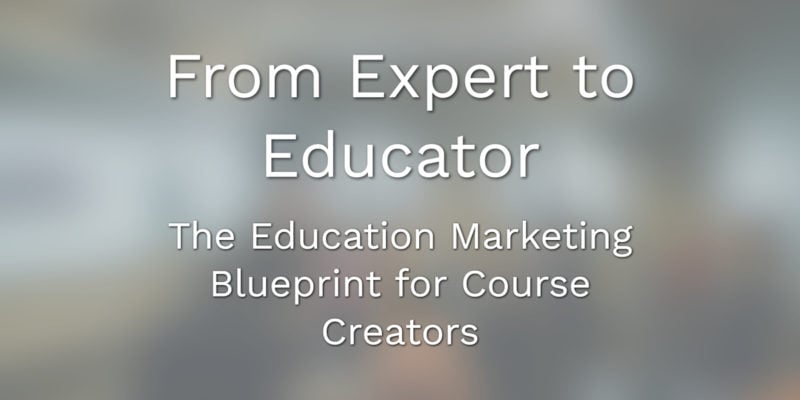You’ve spent months perfecting your online course. The lessons are polished, the content is valuable, and you genuinely believe it can change lives. But when you finally launch it… crickets.
This is the painful reality most educational creators face. You’re brilliant at teaching, but getting people to discover what you’ve built? That’s a completely different skill set.
Here’s what nobody tells you: creating great educational content is only half the battle. The other half is education marketing—and it’s probably not what you think it is.
What Education Marketing Actually Is (And Why It Matters)

Education marketing is the strategic process of connecting people who need to learn something with the educational resources you’ve created to teach them. Whether you’re a YouTuber teaching photography, a course creator explaining financial literacy, or an educational influencer building a following, education marketing is how you bridge the gap between “I have knowledge to share” and “students are actually learning from me.”
Think of it like being a lighthouse. Your ideal students are boats navigating through fog. They have problems, knowledge gaps, careers they want to change. Your job isn’t to chase every boat in the ocean—it’s to shine your light consistently so the right boats know exactly where to find you.
But here’s what makes education marketing fundamentally different from selling products. You’re not selling a thing. You’re selling a transformation.
A future version of someone. The confidence to start a business. The skills to double their income. The knowledge to finally understand something that’s intimidated them for years.
According to Online Course Host’s 2025 market analysis, the global online education market reached $341.72 billion in 2025, growing at 15.75% annually. With only 2.5% market penetration, there’s still significant room for growth. This tells us something crucial—most people who need educational content haven’t found the right creator yet.
The stakes are higher in education than in most industries. Students don’t just spend money—they invest time, energy, and trust. They’re betting on you to deliver on a promise. This means your marketing must be both persuasive and honest.
Why Traditional Marketing Doesn’t Work for Educational Content

If you’ve ever tried following generic marketing advice for your educational content, you’ve probably felt like something was… off. That’s because education marketing operates on different principles than selling shoes or software.
The buying journey is longer. Someone doesn’t wake up, Google “JavaScript course,” and buy the first thing they see. They consume free content for weeks or months. They follow multiple creators. They compare approaches and wait for the right moment.
According to Thinkific’s sales funnel research, the decision process takes time—often weeks to months depending on how familiar someone is with you and your content.
Trust matters more. You’re asking people to trust that you can help them change something fundamental about themselves or their skills. That requires a level of credibility that a clever ad simply can’t build.
Transformation is personal. Someone might watch 47 productivity videos before yours finally clicks. Why? Because you explained it the way their brain needed to hear it. You’re not competing with everyone teaching your subject—you’re connecting with specific people who resonate with your teaching style.
This is why a YouTuber named C.M. de la Vega could generate $13,322 in seven days from a first course launch with just 92,000 subscribers. Others with millions of followers struggle to convert. It’s not about audience size—it’s about trust, positioning, and strategic execution.
The Core Components of Education Marketing That Actually Work

Let me break down what education marketing actually involves, without the fluff or repetition.
Build Awareness Through Valuable Free Content
Your first job is to be discovered. This means creating content that solves real problems in places where your ideal students already hang out.
YouTube functions as both a social platform and search engine. When someone searches “how to start a podcast,” your video can appear for years. Video builds trust faster than any other medium because people see how you teach. They hear your voice. They sense whether you genuinely care.
The strategy works like this: create weekly long-form videos (10-30 minutes) that genuinely solve problems. Don’t make commercials for your course. Make valuable content that demonstrates your expertise. Include clear calls-to-action directing viewers to join your email list.
Social media works differently on each platform. Instagram Reels get significantly more organic reach than other formats. TikTok’s algorithm favors completion rate above all else—your first three seconds must hook viewers. LinkedIn rewards professional development content with longer dwell time.
The universal principle across platforms? Authenticity beats polish. A rough video where you genuinely help someone will outperform a perfectly produced advertisement.
Capture and Nurture Your Audience
Social media followers are rented property. Email subscribers are owned assets.
This matters because platforms change algorithms constantly. Instagram could suppress educational content tomorrow. TikTok could disappear entirely. Your email list stays yours.
Build your list through specific lead magnets, not generic newsletter signups. “Subscribe for tips” is vague and uncompelling. Instead, try this: “Download the exact 10-email sequence I used to launch my first course and generate $8,400 in seven days.”
Sign up for Designrr’s special offer today!
Then send valuable emails consistently—one per week minimum. Not just course announcements. Actually helpful content that solves problems.
According to Learning Revolution’s email research, welcome email sequences should include 3-5 emails over 4-5 days:
- Immediate delivery of your lead magnet
- Your story and teaching approach
- Checking if they used the lead magnet
- Sharing valuable free content
- Asking about their challenges
When you finally promote your course, you’re not interrupting with an ad. You’re offering the natural next step to people you’ve been serving for months.
Convert Interest Into Enrollment

This is where most creators fail. They build an audience but have no system for converting that attention into revenue.
The conversion process needs three elements working together.
First, clear positioning. “Social Media Marketing” competes with thousands of courses. “Instagram for Real Estate Agents” immediately communicates who it’s for and what specific problem it solves. Niche specificity isn’t limiting—it’s focusing your marketing on people most likely to buy.
Second, strategic launch campaigns. The “always available” evergreen approach rarely works for new creators. Instead, create windows of urgency through limited enrollment periods.
A typical launch sequence runs 10-15 emails over 10-14 days:
| Launch Phase | Timeline | What to Send |
|---|---|---|
| Anticipation | Days 1-3 | Build excitement, share your story, tease what’s coming |
| Announcement | Day 4 | Official open, early-bird pricing, clear course details |
| Proof | Days 5-7 | Case studies, address objections, share testimonials |
| Urgency | Days 8-10 | Remind about early-bird deadline, show transformation |
| Final Push | Days 11-14 | Three emails on last day, enrollment closes messaging |
Third, appropriate pricing. Most creators underprice based on fear that lower prices mean easier sales. This kills profit margins and signals low value.
Verifyed’s pricing research shows the sweet spot for comprehensive signature courses typically falls between £497-2,000+ (roughly $600-2,500 USD). For smaller courses or workshops, prices can start lower around $250-500. Price based on the value of transformation, not hours of content.
Think about it this way—if your course teaches someone to start a side business that generates $1,000 per month, charging $297 is a steal. They’ll make their investment back in the first month.
Retain Students and Maximize Lifetime Value
Here’s something most creators miss. Research consistently shows that acquiring new customers costs significantly more than retaining current ones. Yet most marketing advice focuses exclusively on acquisition.
Why does this matter to you right now? Because every student who completes your course becomes a case study, a testimonial, a referral source, and a potential repeat customer. Every student who doesn’t finish is a missed opportunity on all four fronts.
Send engagement emails weekly checking on progress. Trigger re-engagement campaigns when students stop logging in—3-5 emails over two weeks asking what’s blocking them, offering help, and providing easy paths to resume.
Celebrate milestones. Request testimonials from successful students. Present next-step opportunities when students finish. Someone who completes your fundamentals course is the perfect candidate for your advanced course.
Platform Selection for Course Hosting and Email Marketing

You cannot be everywhere. Trying to be everywhere guarantees you’ll do everything poorly.
For course hosting, your needs determine the right choice. Here’s what you need to know about the main options as of 2025:
| Platform | Monthly Cost | Best For | Key Features | Watch Out For |
|---|---|---|---|---|
| Kajabi | $89-499 | Established creators ready to invest | Built-in email, funnels, CRM, affiliate management | Higher cost, learning curve |
| Teachable | $39-399 | Budget-conscious with tech skills | Lower barrier to entry, flexible | Minimal marketing tools, need integrations |
| Podia | $39-89 | New creators wanting all-in-one | Courses, memberships, email included | Less advanced features |
Avoid marketplaces like Udemy for your main business. While they can work for building initial credibility, Udemy takes 37% revenue share for organic sales. The platform also runs frequent promotions that discount courses heavily. You have limited ability to build direct relationships with students or capture email addresses for your own list.
For email marketing, Kit (ConvertKit) excels for creators with visual automations. Pricing starts at $33 monthly for paid plans, with a free option available for getting started. MailerLite offers free plans up to 500 subscribers with robust features for beginners.
The recommendation for new creators? Start with Teachable or Thinkific for courses, Kit or MailerLite for email, and YouTube for free public content. Spend money on tools only after they become constraints. Your first priority is proving the model works.
Common Mistakes That Sink Otherwise Talented Creators

Launch without validation and you’ll spend months perfecting content, then launch to minimal sales and become discouraged. The solution? Pre-sell your course before creating all the content. Survey audiences for their biggest challenges. Run beta launches with small groups using their feedback to build exactly what they need.
Neglect email lists and you’ll email subscribers only at launch. This results in poor conversion because you haven’t built relationships. Consistency matters more than size—a creator with 200 engaged subscribers can out-earn one with 2,000 disengaged subscribers collected through generic giveaways.
Wrong pricing strategy kills profit margins and reduces perceived value. Students associate price with quality. Price based on transformation value, not content hours or competitor pricing.
No clear marketing plan before launch means finishing your course and realizing nobody knows it exists. Marketing strategy should start before course creation begins—ideally, you’re building your audience and validating your idea simultaneously.
Target too broad an audience and you’ll need massive marketing budgets. Specific positioning attracts perfect-fit students who recognize themselves in your messaging immediately. “Social Media Marketing” is generic. “Instagram for Real Estate Agents” is specific and converts better.
Which of these mistakes are you making right now? Most creators make at least two or three without realizing it.
Legal Compliance Requirements You Can’t Ignore

The Federal Trade Commission requires advertising claims to be truthful, not deceptive, and evidence-based. For course creators, this means specific obligations.
You cannot claim “guaranteed to double your revenue” without solid proof. Testimonials must reflect typical experiences or include disclaimers that highlighted results aren’t normal. Material connection disclosures are required for paid endorsements, free products, or affiliate commissions—use clear tags like “#ad” or “I earn commissions from purchases.”
According to FTC endorsement guidelines, the agency actively enforces these requirements. You need data backing your claims.
Accessibility requirements under the Americans with Disabilities Act increasingly apply to digital content. The Department of Justice’s 2024 rule requires public institutions to make websites, apps, and course content meet WCAG 2.1 Level AA standards by April 24, 2026.
This includes:
- Videos with accurate captions
- PDFs readable by screen readers
- Images with alt text
Ethical marketing isn’t harder than unethical marketing—it’s just different. Instead of exaggerating results, showcase real transformations. Instead of fake urgency, create real urgency through launch windows. Students respect honesty and won’t forgive deception.
What Changed in 2025 and Why Old Strategies Don’t Work

Several fundamental shifts changed education marketing between 2023 and 2025. These changes affect how you market your content today.
AI research tools became mainstream. Students increasingly use AI chatbots to research educational options before visiting websites. AI tools for education marketing grew to a $7.57 billion market. This means your content must be structured for AI discoverability—clear FAQs, conversational formatting, structured data.
Platform dynamics evolved significantly. LinkedIn pushed video-first content with better organic reach for video posts. TikTok faced regulatory uncertainty in the U.S., forcing creators to diversify across Instagram Reels and YouTube Shorts. Generic cross-posting fails—each platform demands native content.
Short-form and long-form coexist differently now. The market demands both formats but for different purposes. According to Ambleglow’s 2025 trends, short-form drives engagement and discovery. Long-form builds authority and depth. The winning strategy combines both strategically rather than choosing one.
Authenticity trumps production value. Student-generated “day in the life” content became highly valued. Peer-created content is trusted significantly more than institutional advertising. Polished corporate training loses to authentic expertise from someone who’s been in their shoes.
Are you still using 2023 strategies in 2025? If your content looks like every other polished corporate video, you’re already behind.
Your Action Plan From Understanding to Implementation
Understanding education marketing doesn’t create results. Implementation does.
If you haven’t created your course yet, start building your audience now. Choose one platform (YouTube recommended) and commit to weekly valuable content for six months. Build an email list with a specific lead magnet. Survey your growing audience about their challenges. Pre-sell your course to a small group before creating all the content.
If you have a course but no sales, fix your funnel. You need awareness content (YouTube, social media), a lead magnet capturing emails, an email sequence building trust, and a clear sales page or launch campaign. Identify the weakest link and fix it first.
If you have some sales but want to scale, focus on what’s working. Which traffic source converts best? Double down. Which students refer others most? Interview them to understand why and replicate their experience. Scaling means doing more of what works, not doing new things.
If you’re overwhelmed, start with the smallest viable system. One weekly YouTube video. One lead magnet. One welcome email sequence. One sales page. One launch per quarter. You don’t need every strategy simultaneously—you need one system working before adding the next.
Education marketing connects people who need transformation with the expertise you’ve developed to provide it. Your course genuinely helps people. Your marketing simply makes sure the right people discover it exists.
The students you could help are searching for solutions right now. Some will find inferior solutions because those creators marketed better than you.
What’s stopping you from implementing just one strategy from this guide today?
Start where you are. Use what you have. Do what you can. Your people are waiting.
Frequently Asked Questions About Education Marketing
Get answers to the most common questions about marketing your online courses and educational content
What exactly is education marketing and how is it different from regular marketing?
Education marketing is the strategic process of connecting people who need to learn something with the educational resources you’ve created to teach them. Unlike selling products, you’re selling transformation and a future version of someone. The buying journey is longer, trust matters more, and you’re competing on teaching style and approach rather than just features.
How do I price my online course without undervaluing my expertise?
Price based on the transformation value, not content hours. For comprehensive signature courses, the sweet spot typically falls between $497-2,000. If your course teaches someone to start a side business generating $1,000 monthly, charging $297 is reasonable since they’ll recover their investment quickly. Students associate price with quality, so don’t underprice based on fear.
Should I build my audience before creating my course?
Yes, absolutely. Start building your audience while validating your course idea. Create weekly valuable content on one platform (YouTube recommended), build an email list with specific lead magnets, and survey your growing audience about their challenges. Consider pre-selling your course to a small group before creating all the content.
Which platform should I use to host my online course?
For new creators, start with Teachable ($39-399/month) or Podia ($39-89/month) for budget-friendly options. Kajabi ($89-499/month) is better for established creators ready to invest in built-in marketing tools. Avoid marketplaces like Udemy for your main business as they take 37% revenue share and limit your ability to build direct student relationships.
How important is email marketing for course creators?
Email marketing is crucial because social media followers are rented property while email subscribers are owned assets. Platforms can change algorithms or disappear entirely, but your email list stays yours. Build your list with specific lead magnets and send valuable weekly emails consistently. A creator with 200 engaged subscribers can out-earn one with 2,000 disengaged subscribers.
What’s the best content strategy for attracting course students?
Create weekly long-form videos (10-30 minutes) that genuinely solve problems on YouTube. Don’t make commercials for your course—make valuable content that demonstrates your expertise. Authenticity beats polish. A rough video where you genuinely help someone will outperform a perfectly produced advertisement. Include clear calls-to-action directing viewers to join your email list.
How do I run a successful course launch campaign?
Run a 10-14 day email sequence: Days 1-3 build anticipation, Day 4 is the official announcement with early-bird pricing, Days 5-7 provide proof through case studies and testimonials, Days 8-10 create urgency around deadlines, and Days 11-14 are the final push with three emails on the last day. Limited enrollment periods work better than evergreen “always available” approaches for new creators.
How do I position my course to stand out in a crowded market?
Use niche specificity instead of broad positioning. “Social Media Marketing” competes with thousands of courses, but “Instagram for Real Estate Agents” immediately communicates who it’s for and what specific problem it solves. Niche specificity isn’t limiting—it’s focusing your marketing on people most likely to buy and recognizing themselves in your messaging immediately.
What legal requirements do I need to consider for course marketing?
The FTC requires advertising claims to be truthful and evidence-based. You cannot claim “guaranteed to double your revenue” without solid proof. Testimonials must reflect typical experiences or include disclaimers. Use clear tags like “#ad” for paid endorsements. Additionally, ensure your course content meets accessibility requirements, including captions for videos and screen reader-friendly PDFs.
How do I keep students engaged after they enroll in my course?
Send weekly engagement emails checking on progress and trigger re-engagement campaigns when students stop logging in. Celebrate milestones, request testimonials from successful students, and present next-step opportunities when students finish. Every completed student becomes a case study, testimonial, referral source, and potential repeat customer. Retaining students costs significantly less than acquiring new ones.
Should I focus on short-form or long-form content for marketing?
Use both strategically for different purposes. Short-form content (Instagram Reels, TikTok, YouTube Shorts) drives engagement and discovery, while long-form content builds authority and depth. The winning 2025 strategy combines both rather than choosing one. Create native content for each platform instead of generic cross-posting, as each platform demands different approaches.
What’s the biggest mistake course creators make when marketing?
Launching without validation. Many creators spend months perfecting content, then launch to minimal sales. Instead, pre-sell your course before creating all content, survey audiences for their biggest challenges, and run beta launches with small groups. Use their feedback to build exactly what they need. Marketing strategy should start before course creation begins.
